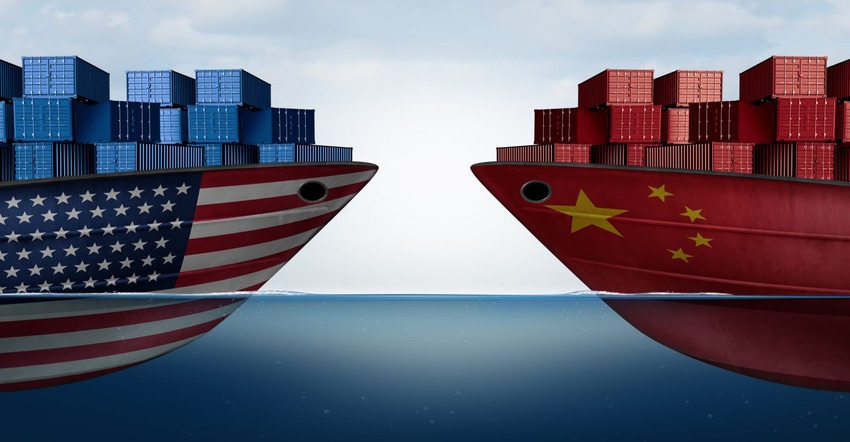Pork council hopes easing of 72% tariff represents good will to resolve trade war with China.

Chinese media reported Friday morning that China is suspending the imposition of punitive tariffs on U.S. pork imports. If realized, it offers a significant opportunity for U.S. pork exports to the country to continue to increase in the aftermath of China's drastic swine herd reduction due to African swine fever. Reports also indicate that soybeans may be included in the tariff rollback.
In the last 30 days, pork prices in China are up 40%, according to David Herring, president of the National Pork Producers Council (NPPC). During a media call featuring Herring and other NPPC staff, they characterized the current situation in China for U.S. pork producers as a “once-in-a-lifetime” opportunity to fill the huge protein hole in China.
U.S. pork producers face retaliatory tariffs of 60% on exports to China as a result of a 25% tariff China lodged in April 2018 in response to U.S. tariffs on Chinese steel and aluminum and then a 25% duty applied in June 2018 and another 10% duty in September 2019, both in retaliation for U.S. tariffs levied on a host of Chinese goods because of China’s treatment of U.S. intellectual property and forced transfers of American technology.
The 60% punitive tariffs are on top of existing 12% duties on U.S. pork, bringing the current tariff rate to 72%. As a result, U.S. pork producers have lost $8 per hog, or more than $1 billion on an annualized basis, according to Iowa State University economist Dermot Hayes.
Nick Giordano, NPPC vice president and counsel, global government affairs, said if China rolls back that tariff, “we’d be able to ship a lot of pork there.” He added that this would be very good not just for U.S. farmers, who continue to struggle, but for China as well, because China doesn’t want food price inflation.
“Pork is somewhat unique, given that it is the most important protein consumed in China, accounting for a significant part of the Consumer Price Index,” Herring said in a statement Friday morning.
Additionally, pork is in short supply in China because African swine fever has ravaged the Chinese hog herd and significantly reduced pork production levels. Some reports indicate that as much as 50% of Chinese’s swine herd has been culled.
“We think we’re at a unique position where we can help both countries and somewhat diffuse the problem,” Giordano said.
Even with retaliatory tariffs in place, the U.S. Meat Export Federation (USMEF) reported that U.S. pork exports to China/Hong Kong in July contributed mightily to the pork industry’s total volume and value records. Exports to the region were a record 68,657 metric tons in July, more than triple a year ago, while value climbed 173% to a record $152.5 million.
For January through July, exports to China/Hong Kong were up 23% in volume to 292,666 mt and rose 3% in value to $580.3 million.
“China’s hog prices soared to record levels in August, and retail pork and poultry prices are also trending sharply higher as China’s African swine fever-related hog shortage intensifies,” USMEF noted.
“When you consider that China is the largest producer and consumer of pork in the world, the importance of this market to U.S. pork producers is clear. U.S. pork exports could single-handedly make a huge dent in the trade imbalance with China,” Herring said. “We are hopeful that this apparent gesture of good will by China leads not only to more sales of U.S. pork but that it contributes to a resolution of U.S.-China trade restrictions."
Exports of U.S. soybeans to China fell to $3.1 billion in 2018, down from $12.2 billion the year before, leaving a record number in storage at the end of last year's harvest.
Matt Herrington, director of commodity analysis and client development at World Perspectives, said soybean and grain markets clearly have been the biggest losers in the trade war, although there is still some hope for increased pork sales to China because of the country's high consumption of pork.
If the trade war gets resolved quickly, he said he expects minimal long-run effects. “To date, we’ve seen mostly minor impacts. If it keeps going, where the tipping point is still unclear,” Herrington said.
About the Author(s)
You May Also Like




.png?width=300&auto=webp&quality=80&disable=upscale)
